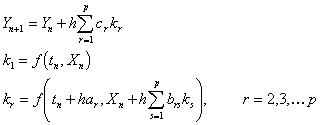The output of a discrete variable method is a set of points ![]() and
the output of the dynamical system is a continuous trajectory
and
the output of the dynamical system is a continuous trajectory ![]() .
For the numerical results to provide a good approximation to the trajectory
we require that the difference
.
For the numerical results to provide a good approximation to the trajectory
we require that the difference
![]()
where ![]() is
some defined error tolerance, at each solution point. This difference is
called the global error and is the accumulated error over all solution
steps. Unfortunately it is extremely difficult to accomplish this and we
have to confine ourselves to controlling the local error
is
some defined error tolerance, at each solution point. This difference is
called the global error and is the accumulated error over all solution
steps. Unfortunately it is extremely difficult to accomplish this and we
have to confine ourselves to controlling the local error
![]()
at each step where ![]() is
the numerical solution obtained on the assumption that the numerical solution
at the previous solution point is exact.
is
the numerical solution obtained on the assumption that the numerical solution
at the previous solution point is exact.
There are two sources of local error, the roundoff error and the truncation error.
Roundoff Error
The roundoff error is the error which arises from the fact that numerical methods are implemented on digital computers which only calculate results to a fixed precision which is dependent on the computer system used. Note that since roundoff errors depend only on the number and type of arithmetic operations per step and is thus independent of the integration stepsize h.
Truncation Error
The truncation error of a numerical method results from the approximation of a continuous dynamical system by a discrete one. The truncation error is machine independent, depending only on the algorithm used and the stepsize h.
An important concept in the analysis of the truncation error is that
of consistency. Basically consistency requires that the discrete variable
method becomes an exact representation of the dynamical system as the stepsize ![]() .
Consistency conditions can be derived for both Linear Multistep and Runge-Kutta
methods.
.
Consistency conditions can be derived for both Linear Multistep and Runge-Kutta
methods.
Linear Multistep Methods
Consider the general linear multistep method
![]()
![]()
We can define the first characteristic poynomial by
![]()
and the second characteristic polynomial by
![]()
We can show that consistency requires that
![]()
Runge-Kutta Methods
The general pth order Runge-Kutta method can be written in the form

Here we have
![]()
and it can be shown that consistency requires that
![]()
(a) the classical 4th order Runge-Kutta method,
(b) the two-step Adams-Bashforth method.

thus
![]()
and hence the method is consistent.

thus
![]()
and hence the method is consistent.
The accuracy with which a consistent numerical method represents a dynamical
system is determined by the order of consistency. The method of
determining this is best illustrated by an example.
The order of consistency is determined by substituting the exact solution ![]() into
the formula of the numerical algorithm and expanding the difference between
the two sides of the formual by Taylor series. The result is then normalised
by multiplying by the scaling factor
into
the formula of the numerical algorithm and expanding the difference between
the two sides of the formual by Taylor series. The result is then normalised
by multiplying by the scaling factor ![]() .
.

thus
![]()
and the method is consistent. Now the truncation error is given by

The order is given by the highest power of h remaining. Hence the method is consistent of order two.